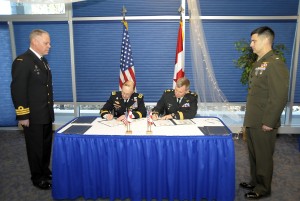By Donna Miles
American Forces Press Service
WASHINGTON, Dec. 11, 2012 – The United States and Canada entered into two new agreements today that expanded their security relationship by promoting closer cooperation in peacefully opening the Arctic and in expanding their bilateral military training and exercise program.
Army Gen. Charles Jacoby Jr., commander of North American Aerospace Defense Command and U.S. Northern Command, joined Canadian Army Lt. Gen. Stuart Beare, commander of Canadian Joint Operations Command, in signing the Tri-Command Framework for Arctic Cooperation during a meeting of the Permanent Joint Board of Defense at the U.S. Air Force Academy in Colorado Springs, Colo.
The agreement emphasizes that the Arctic is not a region of conflict, but rather a place where nations can work together peacefully and the U.S. and Canadian militaries will support other departments and agencies in response to regional threats and hazards when requested and directed, officials said.
The goal is to promote enhanced military cooperation in the Arctic, particularly in support of safety, security and defense operations.

During today’s session, the participants agreed to collaborate more closely in a host of areas, including training, capabilities, research and development, science and technology, domain awareness, communications and operations, all to promote a safe and secure Arctic region, Royal Canadian Air Force Brig. Gen. A.D. “Al” Meinzinger, deputy director of NORAD’s and Northcom’s strategy, policy and plans directorate, told American Forces Press Service.
DOD’s unified defense plan, which President Barack Obama signed in April 2011, designated Northcom as the department’s advocate for Arctic capabilities.
The designation recognizes that the opening of the polar icecap — and the increased presence of human activity — has important strategic implications, Meinzinger said. “With an opening Arctic, we see more vessel traffic, and obviously see a greater need for a deeper understanding of the domain there,” he said.
“We have common interests,” he said. “The eight [Arctic] nations understand that this is a fragile environment, and we have a mutual interest in ensuring the Arctic opens in a peaceful manner and that conflict is not on anybody’s priority list.”
Another agreement signed today expands cooperation in the training and exercise realm and recognizes the shared security interests and budget constraints facing both militaries, Royal Canadian Navy Cmdr. Darren Rich, Canadian Joint Operations Command’s representative to NORAD and Northcom, told American Forces Press Service.
The Tri Command Training and Exercise Statement is aimed at enhancing joint and combined readiness in support of safety, security and defense missions between the Canadian and U.S. militaries.
As examples, Rich noted the Vigilant Shield and Determined Dragon exercises, which bring the three commands together to exercise their ability to protect the U.S. and Canadian homelands and support civil authorities in the event of a natural or manmade disaster.
The new agreement will formalize these exchanges and encourage more cross-border training in ways that strengthen both countries’ defense plans, he said.
“We hope to work through this in an exercise format to find out where the seams and capabilities are,” Rich said. “What we all expect are better planned processes that help us define training objectives far enough in advance to develop the scenarios to test the training objectives. Then, through the [after action review] process, we can see if we met the objectives, where the gaps are, what worked well and what we need to fix.”
The signing “further codifies the bilateral relationship” and helps the two countries’ militaries work together more closely and leverage their resources, Rich said. “It postures us so we can both work together for the safety, security and defense of both our nations’ populations,” he said.
This week’s meeting is the 230th for the Permanent Joint Board of Defense, which stood up after President Franklin Roosevelt and Canadian Prime Minister Mackenzie King solidified the two countries’ military-to-military relationship with the signing of the Ogdensburg Agreement in August 1940. The board is the highest-level bilateral defense and security forum between the United States and Canada. Its collaboration ultimately led to the establishment of what is now the bi-national North American Aerospace Defense Command in 1958.
“This is a wonderful forum where Canadians and Americans discuss issues of common necessity,” Meinzinger said. “We use this venue to put in motion action plans and to work together to address the challenges of the day.”
This week’s Permanent Joint Board of Defense forum follows the signing of a new Combined Defense Plan between the two countries last January.
During the session in Ottawa, Jacoby joined Canadian Army Lt. Gen. Walter Semianiw, commander of the former Canada Command that became part of Canadian Joint Operations Command in October, and established a planning framework to enhance defense cooperation in the event the U.S. or Canadian governments need each other’s assistance, such as during a natural disaster or attack.
Jacoby and Semianiw also renewed for the next two years the Civil Assistance Plan that allows the military from one nation to support the armed forces of the other during a civil emergency. That agreement, in effect since 2008, recognizes the role of each nation’s lead federal agency for emergency preparedness, but facilitates military support of civil authorities once government authorities have agreed on an appropriate response, officials said. In the United States, the Department of Homeland Security would be the lead agency. In Canada, it would be Public Safety Canada.
A third document, the Information Sharing Memorandum of Understanding, was signed last January, and updated existing arrangements to promote information-sharing among the three organizations, officials said.
http://www.defense.gov/news/newsarticle.aspx?id=118768
The two core documents can be downloaded below:
Framework for ARCTIC Cooperation

